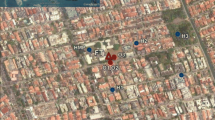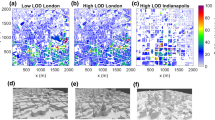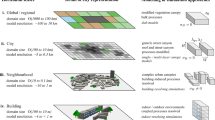Abstract
An urban surface scheme for atmospheric mesoscale models ispresented. A generalization of local canyon geometry isdefined instead of the usual bare soil formulation currently usedto represent cities in atmospheric models. This allows refinement ofthe radiative budgets as well as momentum, turbulent heat and ground fluxes.The scheme is aimed to be as general as possible, in order to representany city in the world, for any time or weather condition(heat island cooling by night, urban wake, water evaporation after rainfalland snow effects).
Two main parts of the scheme are validated against published data.Firstly, it is shown that the evolution of the model-predictedfluxes during a night with calm winds is satisfactory, considering both the longwave budget and the surface temperatures. Secondly, the original shortwave scheme is tested off-line and compared to the effective albedoof a canyon scale model. These two validations show that the radiative energy input to the urban surface model is realistic.
Sensitivity tests of the model are performed for one-yearsimulation periods, for both oceanic and continental climates. The scheme has the ability to retrieve, without ad hoc assumptions, the diurnal hysteresis between the turbulent heat flux and ground heat flux. It reproduces the damping of the daytime turbulent heat flux by the heat storage flux observed in city centres. The latent heat flux is negligible on average,but can be large when short time scales are considered (especially afterrainfall). It also suggests that in densely built areas, domesticheating can overwhelm the net radiation, and supply a continuous turbulentheat flux towards the atmosphere. This becomes very important inwinter for continental climates. Finally, a comparison with a vegetation scheme shows that the suburban environment can be represented with a bare soil formulation for large temporal or spatial averages (typical of globalclimatic studies), but that a surface scheme dedicated to the urban surface is necessary when smaller scales are considered: town meteorological forecasts, mesoscale or local studies.
Similar content being viewed by others
References
Aida, M.: 1982, 'Urban Albedo as a Function of the Urban Structure-A Model Experiment (Part I)', Boundary-Layer Meteorol. 23, 405–413.
André, J., Goutorbe, J., Perrier, A., Becker, F., Bessemoulin, P., Bougeault, P., Brunet, Y., Brutsaert, W., Carlson, T., Cuenca, R., Gash, J., Gelpe, J., Hildebrand, P., Lagouarde, J., Lloyd, C., Mahrt, L., Mascart, P., Mazaudier, C., Noilhan, J., Ottlé, C., Payen, M., Phulpin, T., Stull, R., Shuttleworth, J., Schmugge, T., Taconet, O., Tarrieu, C., Thépenier, R., Valencogne, C., Vidal-Madjar, D., and Weill, A.: 1988, 'Evaporation over Land Surfaces: First Results from HAPEX-MOBILHY Special Observing Period', Ann. Geophys. 6, 477–492.
Arnfield, J., Herbert, J.M., and Johnson, G. T.: 1998, 'A Numerical Simulation Investigation of Urban Canyon Energy Budget Variations', in Proceedings of 2nd AMS Urban Environment Symposium.
Arya, S. P.: 1988, Introduction to Micrometeorology, Academic Press, Inc., New York, 303 pp.
Best, M. J.: 1998, 'Representing Urban Areas in Numerical Weather Prediction Models', in Proceedings of 2nd AMS Urban Environment Symposium.
Bottema, M.: 1997, 'Urban Roughness Modelling in Relation to Pollutant Dispersion', Atmos. Environ. 18, 3059–3075.
Deardorff, J.: 1978, 'Efficient Prediction of Ground Temperature and Moisture with Inclusion of a Layer of Vegetation', J. Geophys. Res. 83, 1889–1903.
Feigenwinter, C., Vogt, R., and Parlow, E.: 1999, 'Vertical Structure of Selected Turbulence Characteristics above an Urban Canopy', Theor. Appl. Climatol. 62, 51–63.
Grimmond, C. and Oke, T.: 1999a, 'Heat Storage in Urban Areas: Local-Scale Observations and Evaluation of a Simple Model', J. Appl. Meteorol. 38, 922–940.
Grimmond, C. and Oke, T.: 1999b, 'Aerodynamic Properties of Urban Areas Derived from Analysis of Surface Form', J. Appl. Meteorol. 38, 1262–1292.
Grimmond, C. S. B., Cleugh, H. A., and Oke, T. R.: 1991, 'An Objective Urban Heat Storage Model and its Comparison with Other Schemes', Atmos. Environ. 25B, 311–326.
Grimmond, C. S. B. and Oke, T. R.: 1991, 'An Evapotranspiration-Interception Model for Urban Areas', Water Resour. Res. 27, 1739–1755.
Grimmond, C. S. B. and Oke, T. R.: 1995, 'Comparison of Heat Fluxes from Summertime Observations in the Suburbs of Four North American Cities', J. Appl. Meteorol. 34, 873–889.
Johnson, G. T., Oke, T. R., Lyons, T. J., Steyn, D. G., Watson, I. D., and Voogt, J. A.: 1991, 'Simulation of Surface Urban Heat Islands under 'Ideal' Conditions at Night. Part I: Theory and Tests Against Field Data', Boundary-Layer Meteorol. 56, 275–294.
Mascart, P., Noilhan, J., and Giordani, H.: 1995, 'A Modified Parameterization of Flux-Profile Relationship in the Surface Layer Using Different Roughness Length Values for Heat and Momentum', Boundary-Layer Meteorol. 72, 331–344.
Menut, L.: 1997, Etude expérimentale et théorique de la couche limite Atmosphérique en agglomération Parisienne (Experimental and Theoretical Study of the ABL in Paris Area), Ph.D. Thesis, University Pierre et Marie Curie, Paris, France, 200 pp.
Mestayer, P.G. and Anquetin, S.: 1995, 'Climatology of Cities', in F.-S. Rys and A. Gyr (eds.), Diffusion and Transport of Pollutants in Atmospheric Meso-Scale Flow Fields, Atmospheric Sciences Library, Kluwer Academic Publishers, Dordrecht, pp. 165–189.
Mills, G. M.: 1993, 'Simulation of the Energy Budget of an Urban Canyon-I. Model Structure and Sensitivity Test', Atmos. Environ. 27B, 157–170.
Noilhan, J.: 1981, 'A Model for the Net Total Radiation Flux at the Surfaces of a Building', Building Environ. 16, 259–266.
Noilhan, J. and Planton, S.: 1989, 'A Simple Parameterization of Land Surface Processes for Meteorological Models', Mon. Wea. Rev. 117, 536–549.
Nunez, M. and T. R. Oke: 1976, 'Long-Wave Radiative Flux Divergence and Nocturnal Cooling of the Urban Atmosphere. II: Within an Urban Canyon', Boundary-Layer Meteorol. 10, 121–135.
Nunez, M. and Oke, T. R.: 1977, 'The Energy Balance of an Urban Canyon', J. Appl. Meteorol. 16, 11–19.
Oke, T. R.: 1987, Boundary Layer Climates, 2nd edn., Methuen, London, 435 pp.
Oke, T. R.: 1988, 'The Urban Energy Balance', Prog. Phys. Geogr. 12, 471–508.
Oke, T., Spronken-Smith, R., Jáuregui, E., and Grimmond, C.: 1999, 'The Energy Balance of Central Mexico City during the Dry Season', Atmos. Environ. 33, 3919–3930.
Petersen, R. L.: 1997, 'A Wind Tunnel Evaluation of Methods for Estimating Surface Roughness Length at Industrial Facilities', Atmos. Environ. 31, 45–57.
Richards, K. and Oke, T. R.: 1998, 'Dew in Urban Environments', in Proceedings of 2nd AMS Urban Environment Symposium.
Ross, S. L. and Oke, T. R.: 1988, 'Tests of Three Urban Energy Balance Models', Boundary-Layer Meteorol. 44, 73–96.
Rotach,M.W.: 1995, 'Profiles of Turbulence Statistics in and above an Urban Street Canyon', Atmos. Environ. 29, 1473–1486.
Roth, M.: 1993, 'Turbulent Transfert: Relationships over an Urban Surface. II: Integral Statistics', Quart. J. Roy. Meteorol. Soc. 119, 1105–1120.
Roth, M. and Oke, T.: 1993, 'Turbulent Transfert: Relationships over an Urban Surface. II: Spectral Characteristics', Quart. J. Roy. Meteorol. Soc. 119, 1071–1104.
Rowley, F.B., Algren, A. B., and Blackshaw, J. L.: 1930, 'Surface Conductances as Affected by Air Velocity, Temperature and Character of Surface', ASHRAE Trans. 36, 429–446.
Rowley, F. B. and Eckley, W. A.: 1932, 'Surface Coefficients as Affected by Wind Direction', ASHRAE Trans. 38, 33–46.
Schlosser, C.A., Robock, A., Vinnikov, K., Speranskaya, N., and Xue, Y.: 1997, '18-Year Land Surface Hydrology Model Simulations for a Midlatitude Grassland Catchment in Valdai, Russia', Mon. Wea. Rev. 125, 3279–3296.
Seaman, N. L., Ludwig, F. F., Donall, E. G., Warner, T. T., and Bhumralkar, C.M.: 1989, 'Numerical Studies of Urban Planetary Boundary-Layer Structure under Realistic Synoptic Conditions', J. Appl. Meteorol. 28, 760–781.
Soux, A., Oke, T. R., and Voogt, J. A.: 1998, 'Modelling and Remote Sensing of the Urban Surface', in Proceedings of 2nd AMS Urban Environment Symposium.
Sturrock, N. and Cole, R.: 1977, 'The Convective Heat Exchange at the External Surface of Buildings', Building Environ. 12, 207–214.
Taha, H.: 1999, 'Modifying a Mesoscale Meteorological Model to Better Incorporate Urban Heat Storage: A Bulk-Parameterization Approach', J. Appl. Meteorol. 38, 466–473.
Terjung, W. H. and O'Rourke, P. A.: 1980, 'Influences of Physical Structures on Urban Energy Budgets', Boundary-Layer Meteorol. 19, 421–439.
Wieringa, J.: 1993, 'Representative Roughness Parameters for Homogeneous Terrain', Boundary-Layer Meteorol. 63, 323–363.
Author information
Authors and Affiliations
Rights and permissions
About this article
Cite this article
Masson, V. A Physically-Based Scheme For The Urban Energy Budget In Atmospheric Models. Boundary-Layer Meteorology 94, 357–397 (2000). https://doi.org/10.1023/A:1002463829265
Issue Date:
DOI: https://doi.org/10.1023/A:1002463829265




